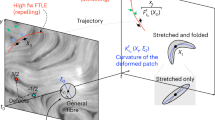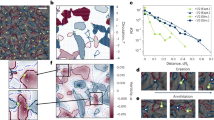Abstract
Active nematics are out-of-equilibrium fluids composed of rod-like subunits, which can generate large-scale, self-driven flows. We examine a microtubule-kinesin-based active nematic confined to two dimensions, exhibiting chaotic flows with moving topological defects. Applying tools from chaos theory, we investigate self-driven advection and mixing on different length scales. Local fluid stretching is quantified by the Lyapunov exponent. Global mixing is quantified by the topological entropy, calculated from both defect braiding and curve extension rates. We find excellent agreement between these independent measures of chaos, demonstrating that the extensile stretching between microtubules directly translates into macroscopic braiding of positive defects. Remarkably, increasing extensile activity (through ATP concentration) does not increase the dimensionless topological entropy. This study represents an application of chaotic advection to the emerging field of active nematics and quantification of the collective motion of an ensemble of defects (through topological entropy) in a liquid crystal.
This is a preview of subscription content, access via your institution
Access options
Access Nature and 54 other Nature Portfolio journals
Get Nature+, our best-value online-access subscription
$29.99 / 30 days
cancel any time
Subscribe to this journal
Receive 12 print issues and online access
$209.00 per year
only $17.42 per issue
Buy this article
- Purchase on Springer Link
- Instant access to full article PDF
Prices may be subject to local taxes which are calculated during checkout





Similar content being viewed by others
Data availability
The data that support the findings of this study are available from the corresponding authors on reasonable request.
Code availability
The MATLAB code for computing nematic director fields and topological defects is available on request from K.A.M. The E-tec code is available in Python from S.A.S. (smiths@mtholyoke.edu) on request.
References
Toner, J. & Tu, Y. Long-range order in a two-dimensional dynamical XY model: how birds fly together. Phys. Rev. Lett. 75, 4326–4329 (1995).
Katz, Y., Tunstrøm, K., Ioannou, C. C., Huepe, C. & Couzin, I. D. Inferring the structure and dynamics of interactions in schooling fish. Proc. Natl Acad. Sci. USA 108, 18720–18725 (2011).
Buhl, J. et al. From disorder to order in marching locusts. Science 312, 1402–1406 (2006).
Saw, T. B. et al. Topological defects in epithelia govern cell death and extrusion. Nature 544, 212–216 (2017).
Kawaguchi, K., Kageyama, R. & Sano, M. Topological defects control collective dynamics in neural progenitor cell cultures. Nature 545, 327–331 (2017).
Prost, J., Jülicher, F. & Joanny, J.-F. Active gel physics. Nat. Phys. 11, 111–117 (2015).
Sokolov, A., Aranson, I. S., Kessler, J. O. & Goldstein, R. E. Concentration dependence of the collective dynamics of swimming bacteria. Phys. Rev. Lett. 98, 158102 (2007).
Wensink, H. H. et al. Meso-scale turbulence in living fluids. Proc. Natl Acad. Sci. USA 109, 14308–14313 (2012).
Dunkel, J. et al. Fluid dynamics of bacterial turbulence. Phys. Rev. Lett. 110, 228102 (2013).
Palacci, J., Sacanna, S., Steinberg, A. P., Pine, D. J. & Chaikin, P. M. Living crystals of light-activated colloidal surfers. Science 339, 936–940 (2013).
Yan, J. et al. Reconfiguring active particles by electrostatic imbalance. Nat. Mater. 15, 1095–1099 (2016).
Narayan, V., Menon, N. & Ramaswamy, S. Nonequilibrium steady states in a vibrated-rod monolayer: tetratic, nematic, and smectic correlations. J. Stat. Mech. Theory Exp. 2006, P01005 (2006).
Ndlec, F. J., Surrey, T., Maggs, A. C. & Leibler, S. Self-organization of microtubules and motors. Nature 389, 305–308 (1997).
Schaller, V., Weber, C., Semmrich, C., Frey, E. & Bausch, A. R. Polar patterns of driven filaments. Nature 467, 73–77 (2010).
Sanchez, T., Chen, D. T. N., DeCamp, S. J., Heymann, M. & Dogic, Z. Spontaneous motion in hierarchically assembled active matter. Nature 491, 431–434 (2012).
Henkin, G., DeCamp, S. J., Chen, D. T. N., Sanchez, T. & Dogic, Z. Tunable dynamics of microtubule-based active isotropic gels. Phil. Trans. R. Soc. Lond. A 372, 20140142 (2014).
Giomi, L. Geometry and topology of turbulence in active nematics. Phys. Rev. X 5, 031003 (2015).
DeCamp, S. J., Redner, G. S., Baskaran, A., Hagan, M. F. & Dogic, Z. Orientational order of motile defects in active nematics. Nat. Mater. 14, 1110–1115 (2015).
Guillamat, P., Ignés-Mullol, J. & Sagués, F. Control of active liquid crystals with a magnetic field. Proc. Natl Acad. Sci. USA 113, 5498–5502 (2016).
Doostmohammadi, A., Shendruk, T. N., Thijssen, K. & Yeomans, J. M. Onset of meso-scale turbulence in active nematics. Nat. Commun. 8, 15326 (2017).
Guillamat, P., Ignés-Mullol, J. & Sagués, F. Taming active turbulence with patterned soft interfaces. Nat. Commun. 8, 564 (2017).
Shendruk, T. N., Doostmohammadi, A., Thijssen, K. & Yeomans, J. M. Dancing disclinations in confined active nematics. Soft Matter 13, 3853–3862 (2017).
Lemma, L. M., DeCamp, S. J., You, Z., Giomi, L. & Dogic, Z. Statistical properties of autonomous flows in 2D active nematics. Soft Matter 15, 3264–3272 (2019).
Ramaswamy, S. The mechanics and statistics of active matter. Annu. Rev. Condens. Matter Phys. 1, 323–345 (2010).
Marchetti, M. C. et al. Hydrodynamics of soft active matter. Rev. Mod. Phys. 85, 1143–1189 (2013).
Aref, H. Stirring by chaotic advection. J. Fluid Mech. 143, 1–21 (1984).
Aref, H. et al. Frontiers of chaotic advection. Rev. Mod. Phys. 89, 025007 (2017).
Boyland, P. L., Aref, H. & Stremler, M. A. Topological fluid mechanics of stirring. J. Fluid Mech. 403, 277–304 (2000).
Muzzio, F. J., Swanson, P. D. & Ottino, J. M. The statistics of stretching and stirring in chaotic flows. Phys. Fluids A 3, 822–834 (1991).
Chaiken, J., Chevray, R., Tabor, M., Tan, Q. M. & Stuart, J. T. Experimental study of Lagrangian turbulence in a Stokes flow. Proc. R. Soc. Lond. A 408, 165–174 (1986).
Aref, H. & Balachandar, S. Chaotic advection in a Stokes flow. Phys. Fluids 29, 3515–3521 (1986).
Vikhansky, A. Chaotic advection of finite-size bodies in a cavity flow. Phys. Fluids 15, 1830–1836 (2003).
Gouillart, E., Thiffeault, J.-L. & Finn, M. D. Topological mixing with ghost rods. Phys. Rev. E 73, 036311 (2006).
Finn, M. D. & Thiffeault, J.-L. Topological optimization of rod-stirring devices. SIAM Rev. 53, 723–743 (2011).
Thiffeault, J.-L. Braids of entangled particle trajectories. Chaos 20, 017516 (2010).
Allshouse, M. R. & Thiffeault, J.-L. Detecting coherent structures using braids. Physica D 241, 95–105 (2012).
Budišić, M. & Thiffeault, J.-L. Finite-time braiding exponents. Chaos 25, 087407 (2015).
Roberts, E., Sindi, S., Smith, S. A. & Mitchell, K. A. Ensemble-based topological entropy calculation (E-tec). Chaos 29, 013124 (2019).
Hirokawa, N., Noda, Y., Tanaka, Y. & Niwa, S. Kinesin superfamily motor proteins and intracellular transport. Nat. Rev. Mol. Cell Biol. 10, 682–696 (2009).
Lu, W., Winding, M., Lakonishok, M., Wildonger, J. & Gelfand, V. I. Microtubule–microtubule sliding by kinesin-1 is essential for normal cytoplasmic streaming in Drosophila oocytes. Proc. Natl Acad. Sci. USA 113, E4995–E5004 (2016).
Young, L.-S. in Entropy (eds Greven, A., Keller, G. & Warnecke, G.) 313–327 (Princeton Univ. Press, 2003).
Visscher, K., Schnitzer, M. J. & Block, S. M. Single kinesin molecules studied with a molecular force clamp. Nature 400, 184–189 (1999).
Lam, A. T., Curschellas, C., Krovvidi, D. & Hess, H. Controlling self-assembly of microtubule spools via kinesin motor density. Soft Matter 10, 8731–8736 (2014).
Tan, A. J., Chapman, D. E., Hirst, L. S. & Xu, J. Understanding the role of transport velocity in biomotor-powered microtubule spool assembly. RSC Adv. 6, 79143–79146 (2016).
Hemingway, E. J., Mishra, P., Marchetti, M. C. & Fielding, S. M. Correlation lengths in hydrodynamic models of active nematics. Soft Matter 12, 7943–7952 (2016).
Thielicke, W. & Stamhuis, E. J. PIVlab—towards user-friendly, affordable and accurate digital particle image velocimetry in MATLAB. J. Open Res. Softw. 2, e30 (2014).
Crocker, J. C. & Grier, D. G. Methods of digital video microscopy for colloidal studies. J. Colloid Interface Sci. 179, 298–310 (1996).
Acknowledgements
Our group is grateful to Z. Dogic for the generous contribution of microtubules and molecular motors and to L. Lemma for sample preparation. We also acknowledge useful discussions with S. Sindi. The authors acknowledge generous funding from the National Science Foundation, through several awards (DMR-1808926), NSF-CREST: Center for Cellular and Biomolecular Machines at UC Merced (HRD-1547848), and from the Brandeis Biomaterials facility MRSEC-1420382.
Author information
Authors and Affiliations
Contributions
L.S.H. and K.A.M. designed the study. A.J.T. carried out the experiments. A.J.T., E.R., S.A.S., U.A.O., J.A., S.F. and K.A.M. performed analysis. L.S.H., K.A.M. and A.J.T. wrote the paper.
Corresponding authors
Ethics declarations
Competing interests
The authors declare no competing interests.
Additional information
Peer review information: Nature Physics thanks Jordi Ignes-Mullol, Idan Tuval and Julia Yeomans for their contribution to the peer review of this work.
Publisher’s note: Springer Nature remains neutral with regard to jurisdictional claims in published maps and institutional affiliations.
Supplementary information
Supplementary Information
Supplementary material and Supplementary Figs. 1–6.
Supplementary Video 1
Fluorescence microscopy video of the microtubule/kinesin active nematic at 50 µM ATP concentration.
Supplementary Video 2
Fluorescence microscopy video of the active nematic with topological defects tracked at 50 µM ATP concentration. +1/2 defects are shown by white circles and –1/2 defects are shown by yellow triangles.
Supplementary Video 3
Optical microscopy bright-field video of the active nematic with tracked beads marked in blue and numbered. 50 µM ATP concentration.
Supplementary Video 4
Optical microscopy bright-field video of the active nematic at 50 µM ATP concentration with tracked beads marked and numbered. A nematic contour growing between a pair of tracked beads is shown in blue.
Supplementary Video 5
Fluorescence microscopy video of the active nematic at 50 µM ATP concentration with topological defects marked and tracked. +1/2 defects are shown by white circles and –1/2 defects are shown by yellow triangles. A nematic contour growing between a pair of tracked defects is shown in blue.
Supplementary Video 6
Braiding motion of the tracked +1/2 defects with E-tec triangulation showing the growth of the stretched mesh (red lines). 50 µM ATP concentration.
Rights and permissions
About this article
Cite this article
Tan, A.J., Roberts, E., Smith, S.A. et al. Topological chaos in active nematics. Nat. Phys. 15, 1033–1039 (2019). https://doi.org/10.1038/s41567-019-0600-y
Received:
Accepted:
Published:
Issue Date:
DOI: https://doi.org/10.1038/s41567-019-0600-y
This article is cited by
-
Spontaneous self-constraint in active nematic flows
Nature Physics (2024)
-
Defects show self-constraint in active nematics
Nature Physics (2024)
-
Defect-mediated dynamics of coherent structures in active nematics
Nature Physics (2023)
-
Self-mixing in microtubule-kinesin active fluid from nonuniform to uniform distribution of activity
Nature Communications (2022)
-
Competing instabilities reveal how to rationally design and control active crosslinked gels
Nature Communications (2022)



